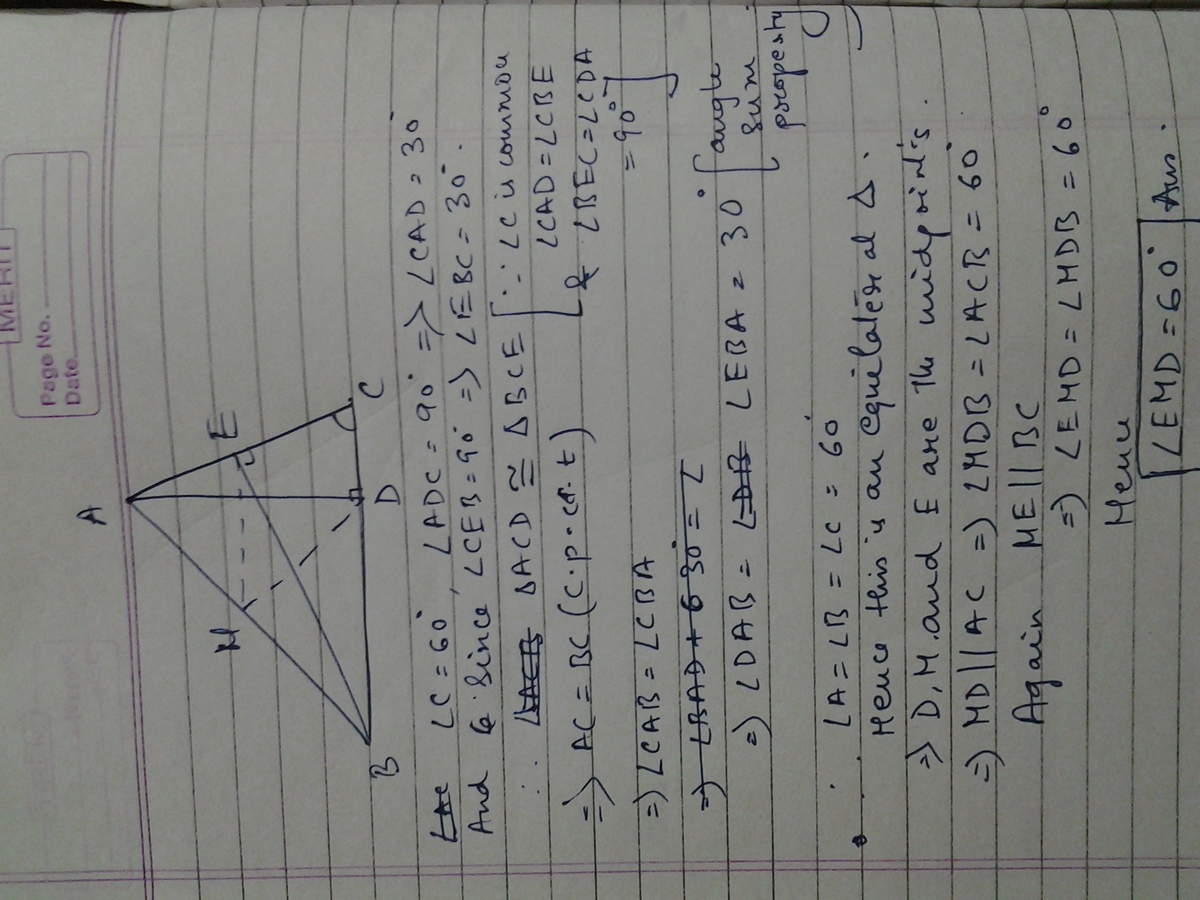BdMO 2014 Problem
 In
△
A
B
C
,
∠
C
=
6
0
∘
.
A
D
and
B
E
are perpendicular on
B
C
and
A
C
respectively.
M
is the midpoint of
A
B
. Find the measure of
∠
E
M
D
in degrees.
In
△
A
B
C
,
∠
C
=
6
0
∘
.
A
D
and
B
E
are perpendicular on
B
C
and
A
C
respectively.
M
is the midpoint of
A
B
. Find the measure of
∠
E
M
D
in degrees.
The answer is 60.
This section requires Javascript.
You are seeing this because something didn't load right. We suggest you, (a) try
refreshing the page, (b) enabling javascript if it is disabled on your browser and,
finally, (c)
loading the
non-javascript version of this page
. We're sorry about the hassle.
15 solutions
till the const. of circle it is ok but then how is angle EMD60
Log in to reply
Angle subtended by an arc at the centre = 2 x angle subtended by that arc on the circumference of circle. => angEMD = 2 x angDAE (Both the angles lie on the same arcDE) = 2 x 30 (In triangleADC, apply angle sum property) = 60
I did the same
o sorry i got it
nice solution
good solution....
good one
nice question
this is great! :)
I guessed it
same here!!
How have you concluded that M is the centre?
Log in to reply
In a right angled triangle(here triangleADB), the midpoint of the hypotenuse is the circumcentre of the triangle. Since the midpt of hypt. AB here is M, M is the centre of the circumcircle of triangleABD.
m is the mid point.
Allah is the most powerful
Let H be the orthocentre of the triangle ABC. Clearly, HECD is cyclic(since E+D=9+90=180)
Let O be the centre of the quad EHCD. Clearly, angle EOD=120(twice to that of ECD)
We know that, EODM is cyclic (since E,O,D,M are points on the nine point circle)
therefore, angleEMD + ange EOD = 180 which gives that EMD=60
how do you know that <ECD is 60?
∠ B D A = ∠ A E B = 9 0 ° These are angles subtended by chord AB on a circle which passes through A, E, D and B. Since the angles are equal to 90°, AB is the diameter of the circle i.e M is the centre. Now we know that ∠ C = 60°. Therefore ∠ E B C = 30°. Now consider chord ED. We know that the angle subtended by the chord at centre is equal to twice the angle subtended by the same chord anywhere in the same part of the circle. So, ∠ E M D = 2 ∠ E B C = 60°.
Since perpeiculars make 90 degree and angle BCA is 60 degree given,angles CAD AND CBE are 30 degree.. Since M is middle point of AB ,AMD becmes equlateral trianle and therefore all anles are 60 degree .So, angle EMD is 60 degrees Ans
K.K.GARG.India
It's a natural consecuence of the 9 points circunference theorem. However, this is like killing a fly with a bazooka.
60 degrees.. since, the angle M must b same 4 any triangle with c=60 dgree.. consider a equlatrl triangl wit all angle equals 60 dgree... 4 equ triangle, perpendicular,median and angle bisectors are same. thus by using these proptys angle m=60 dgree

Sorry for the picture quality.
If bisector AD and Be is P. I just see congruen between APE and BPD is congruen.. So ABC is triangle with the same leght.. It mean EMD is pedal of ABC wich have measure is 60
For the perpendicular bisector of AC to pass through B, angle BAC must be equal to angle BCA which is 60 degrees, leaving 60 degrees for angle ABC. Hence, ABC is an equilateral triangle. If AD is perpendicular to BC, it must also bisect it (because the triangle ABC is equilateral). As, M, E and D are the midpoints of each side of the equilateral triangle, it follows that triangle MED is also an equilateral and angle EMD is 60 degrees.
As BE is a perpendicular on AC so CEB=90 and C=60 so EBC=30 again as AD is a perpendicular on BC so ADB=90 now lets consider P and Q are points on MD and AD respectively as BP and MQ are perpendiculars on MD and AD respectively.As BP a perpendicular MD so BPD=90 and EBC=PBD=30 thus in triangle BPD, BDP=60.Now QDM=ADB-BDP=90-60=30.Again as MQ a perpendicular on AD so MQD=90 and QDM=30 so in triangle QMD, DMQ=60 which means EMD=60
we can draw a circle with m as centre and the circle passes through a,b,d,e........ then u can solve it
Since Traingle BCE and Triangle BEA are both right triangles and given that angle C is 60 deg, Special Triangles (30-60-90) is applicable to determine angle EMD.
Regardless of the illustration, Triangle ABC is an equilateral triangle with side 2, and since M is the midpoint of side AB, therefore side BM is 1. Since angle EBC and angle ABE are both 30 deg, therefore angle B = 30 deg + 30 deg = 60 deg and Side BD is 1. With that, Triangle BMD is also an equilateral triangle with side 1.
Since angle BMD and AME are both 60 degrees and a straight angle measures 180 deg, therefore angle EMD is equal to 60 deg.
ABE <> 30 !
Thales theorem teaches us that when 2 triangles have the same angle and a commom side they are similar, thus their angles are equal therefore it is a matter of re-arranging the triangle to fit with the known 90 º and we find that EMD is in the place of the 60
we can see ME=MA and MD= MB.so <AME=180-2 <A and <BMD=180-2<B.we also have <A+<B=120,which gives <EMD=60
"we can see ME=MA and MD= MB," I also considered this to solve the problem, but I dont know why this applies, do you?
Clearly, quadrilateral A E C B is cyclic and A B is the diameter of the circumscribing circle. M is the midpoint of A B means that M is the centre of the circumscribing circle. Now, in △ A C D , ∠ C = 6 0 ∘ and hence ∠ C A D = ∠ E A D = 9 0 ∘ − 6 0 ∘ = 3 0 ∘ . Now ∠ E M D = 2 ∠ E A D = 6 0 ∘
What type of quadrilateral is AECB?
Log in to reply
It is a triangle...:D
Log in to reply
Then again, every triangle is a cyclic quadrilateral with one of its side equal to zero.
U've made a typo. quadrilateral AEDB is cyclic (not AECB).
How AECB is a quadrilateral........! it does n't seem so...! i hope it's a triangle..
i am not able to understand your solution booooooooooooooo....................
We can find that angle EAD and angle EBD are of 30° so we can cinstruct a circle with ED as a chord and passing through A and B. Now, as angle AEB is 90°, thus AB is the diameter and M the centre. Thus angle EMD is 60°